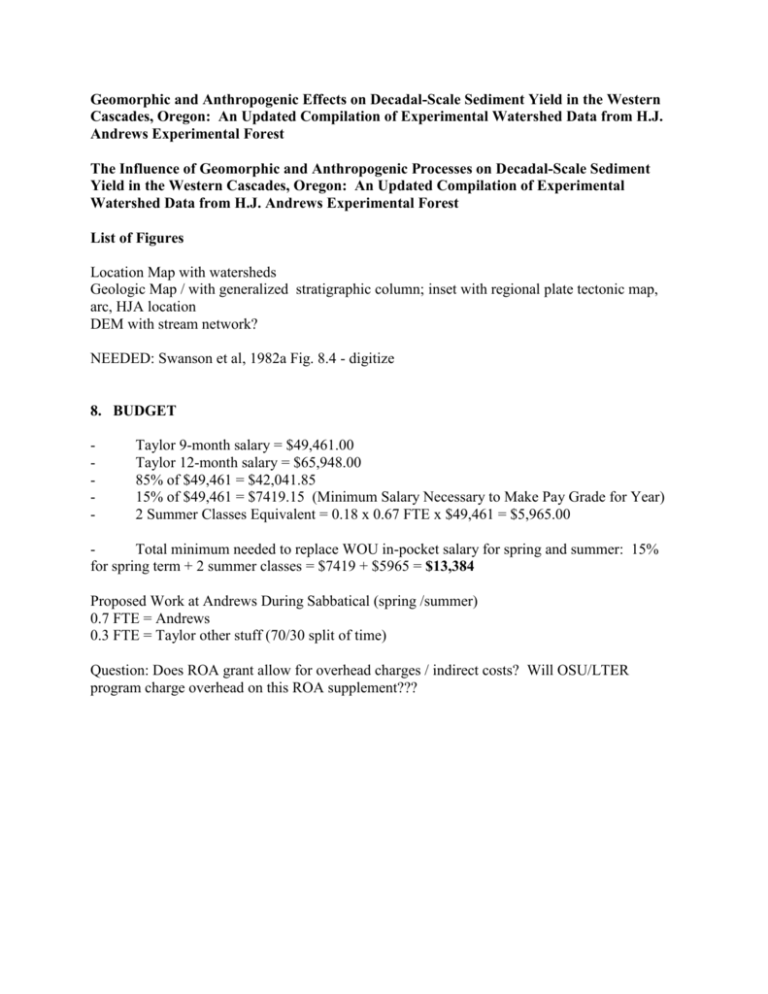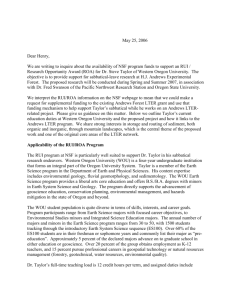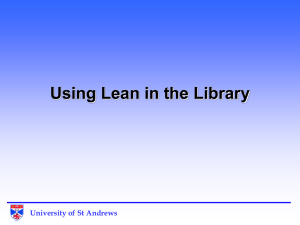HJA WS9-10 Project Notes - Western Oregon University
advertisement

Geomorphic and Anthropogenic Effects on Decadal-Scale Sediment Yield in the Western Cascades, Oregon: An Updated Compilation of Experimental Watershed Data from H.J. Andrews Experimental Forest The Influence of Geomorphic and Anthropogenic Processes on Decadal-Scale Sediment Yield in the Western Cascades, Oregon: An Updated Compilation of Experimental Watershed Data from H.J. Andrews Experimental Forest List of Figures Location Map with watersheds Geologic Map / with generalized stratigraphic column; inset with regional plate tectonic map, arc, HJA location DEM with stream network? NEEDED: Swanson et al, 1982a Fig. 8.4 - digitize 8. BUDGET - Taylor 9-month salary = $49,461.00 Taylor 12-month salary = $65,948.00 85% of $49,461 = $42,041.85 15% of $49,461 = $7419.15 (Minimum Salary Necessary to Make Pay Grade for Year) 2 Summer Classes Equivalent = 0.18 x 0.67 FTE x $49,461 = $5,965.00 Total minimum needed to replace WOU in-pocket salary for spring and summer: 15% for spring term + 2 summer classes = $7419 + $5965 = $13,384 Proposed Work at Andrews During Sabbatical (spring /summer) 0.7 FTE = Andrews 0.3 FTE = Taylor other stuff (70/30 split of time) Question: Does ROA grant allow for overhead charges / indirect costs? Will OSU/LTER program charge overhead on this ROA supplement??? List of Tables Summary Table of watershed characteristics, previous work, years of data coverage, products, and scientific contributions; time range of data, type of data, see Grant and Jones 2002 for summary table) Andrews / PNW station Facilities at FSL Copier Rm 301 Fred Office = Rm 344 Library / Report Repository = Rm 349 Don Henshaw = data manager = Rm 356 Theresa Valentine = GIS manager (next to Don Henshaw) Theresa.valentine@oregonstate.edu Field Tech / manager = Craig Creel Sherrie Johnson = aquatic biologist, scientist in charge of field team (fred’s ultimate replacement) Other facilities /studies to draw models from: Casper Creek experiment station (in california??); Mt. St. Helens Desiree Tullos, new asst. prof. in bioresource engineering, interested in cultivating projects at Andrews, check web site for expertise / interests. ______________________________________ Project Notes - Working Titles _______________________________________________________________________ The effects of geomorphic and anthropogenic processes on decadal-scale sediment yield in headwater basins of the western Cascades, Oregon Geomorphic and anthropogenic influences on decadal-scale sediment yield in headwater basins of the western Cascades, Oregon The effects of geomorphic processes and forest management practices on decadal-scale sediment yield in headwater basins of the western Cascades, Oregon Decadal-scale sediment yield in headwater basins of the western Cascades, Oregon The effects of forest management practices on decadal-scale sediment yield in headwater basins of the western Cascades, Oregon _____________________________________________________________ Andrews Questions and Ideas Lidar – has not been flown = why not? Is this something to lobby / contribute to? DOGAMI? Partnership? Andrews Air Photos – where? UO? USFS? In House? Goal – Sediment discharge vs. time Are there terrain and other watershed-scale models available for Lookout Creek? Any Lancaster type modeling? Any sediment transport models? Key question: when considering sed. Yield over time in paired basin studies, must consider geomorphic processes in addition to anthropogenic control / forestry practice. Based on work on Swanson and Frederickson (1982) and Grant and Wolff (1990) – 1964 flood has effect + veg. recovery + logging practice = controls sed. Yield vs. time. __________________________________________________________ Andrews WS9 - WS10 Project Notes “Water Year = Oct 1 – Sept. 30” Area Conversion 1 ha = 10,000 sq. m = 0.01 sq. km = 2.471 ac WS10 – clear cut, 1975 “treated basin” - drainage area = 10 ha = 0.1 sq. km = 100,000 sq. m = 24.7 ac - roads = none constructed, logging through skyline lifting from ridge tops; slash was left unburned and in place, site replanted with 2.4 x 2.4 m (8 ft x 8ft) spacing of doug fir seedlings. - slopes = steeper; 60% - over 100%; avg stream channel grad = 24 deg.; side slopes 25-50 deg. (latter from Cromack et al); hillslopes average 65% and channel averages 18% (from Swanson and others, 1982) - Aspect = ? - Significant Hydrologic Events at Andrews o Storms: dec. 1964 o Drought: 1977 o Storms: feb. 1986 o Storms: feb. 1996 - Elevation Range: 425-700 m (Cromack says 430 m – 670 m) - Roads = 0 km / km-2 - Soils: residual and colluvial clay loam, pyroclastic parent, from Cromack et al, soils = typic distrochrepts, gravelly clay loams, clasts = 15-50% of soil volume - Vegetation: prior to logging, 400-500-yr old Douglas fir mixed with western Hemlock and younger Doug. Fir - Avg ppt = 230 cm (station 1.5 km away); at this elev. Snow cover sporadic, lasting 12 weeks, melting within 1-2 days WS 9 – native, old growth “untreated basin” or “control” basin - drainage area = 9 ha = 0.09 sq. km = 90,000 sq. m = 22.2 ac - roads = none??? - Slopes = less steep - Aspect = southerly - Elevation Range: 425-700 m elev (?? Same as WS10) - Roads = 0 km / km-2 - Soils: residual and colluvial clay loam, pyroclastic parent - Vegetation: 450-yr old Douglas fir mixed with western Hemlock and younger Doug. fir For Comparison – WS1, 2, and 3 WS1, 2, 3 Areas WS1 = 0.96 sq. km = 237 ac WS2 = 0.6 sq. km = 148 ac WS3 = 1.01 sq. km = 249 ac Lookout Creek - main gaging station Q 1950-2005 mean annual Q 1950-2005 CFS = 3.5 CMS CFS CFS CFS = = = 227 CMS 189 CMS 118 CMS Seasonal Averages - Lookout Creek Winter Nov - April 197 CFS = 5.6 CMS Summer May-Sept = 1.5 CMS Max Q 1 Feb. 1996 Max Q 2 Dec. 1964 Max Q 3 Jan 1972 122.571 8000 6660 4180 52 CFS








